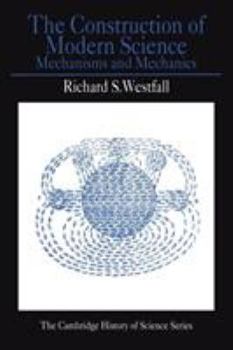The Construction of Modern Science: Mechanisms and Mechanics
Select Format
Select Condition 
Book Overview
This introduction to the history of science in the seventeenth century examines the so-called 'scientific revolution' in terms of the interplay between two major themes. The Platonic-Pythagorean tradition looked on nature in geometric terms with the conviction that the cosmos was constructed according to the principles of mathematical order, while the mechanical philosophy conceived of nature as a huge machine and sought to explain the hidden mechanisms behind phenomena. Pursuing different goals, these two movements of thought tended to conflict with each other, and more than the obviously mathematical sciences were affected - the influence spread as far as chemistry and the life sciences. As this book demonstrates, the full fruition of the scientific revolution required a resolution of the tension between the two dominant trends.
Format:Paperback
Language:English
ISBN:0521292956
ISBN13:9780521292955
Release Date:January 1978
Publisher:Cambridge University Press
Length:190 Pages
Weight:0.57 lbs.
Dimensions:0.4" x 5.9" x 9.0"
Customer Reviews
3 ratings
The freedom of thought!
Published by Thriftbooks.com User , 19 years ago
Classical antiquity and the Greek and Roman worlds are the source of and foundation of modern science. Without Aristotle, Pythagoras, Democritus, Ptolemy, Vitruvius, Archimedes, Ptolemy and many others we would not have Newton, Malpighi, Leibniz, Kepler, Galileo, Descartes, Copernico or Einstein. In this sense this book is a very interesting journey through the development of the Modern Science, and its countless obstacles to surmount with the Status Quo of different ages and historical moments Albert Einstein stated once "The science without religion is cripple but the religion without science is blind." Totally recommended.
Crystal clear style, illuminating depth on the scientific process
Published by Thriftbooks.com User , 19 years ago
There are several aspects of this book that render it superior but the one aspect which stands out is manner in which the author presents the reasoning behind the development of a revolutionary scientific idea from the perspective of the originator of the idea, and the process by which the originator used developing philosophical trends, and scientific methods to fully realize a new idea despite the mental entanglements of centuries-old "factual" dogma or presuppositions about natural law. Beautifully presented and fully relevant diagrams as well. The first chapter is the clearest description I've ever read of the rationale behind the development of Kepler's Laws.
Great introduction to the 17th century scientific revolution
Published by Thriftbooks.com User , 25 years ago
This book really is a great introduction to the scientific revolution of the 17th century. It's part of a series of books called "History of Science Series" and is dedicated to bringing the history of science to a wider audience. It presents the general reader with an accurate, short narrative and analysis of the scientific revolution of the 17th century. Unlike other books on this subject it does not require the reader to be familiar with a lot of technical background knowledge.Two major themes dominated the period covered in the book; the Platonic-Pythagorean tradition, which looked on nature in geometric terms, and the mechanical philosophy, which conceived of nature as a huge machine and sought to explain the hidden mechanisms behind phenomena. These themes run through the various chapters of the book. Starting out in the first chapter with the copernican revolution in astronomy (the heliocentric theory) it shows how two men, Kepler and Galileo, reformed the theory and opened up new questions for the comming century. The following chapters cover the various sciences such as mechanics, chemistry and biology. After an interluding chapter covering the organization of the scientific enterprise (showing that universities were not always the principal centers of scientific research) it ends with two chapters in which the two themes mentioned above are drawn together and ultimately lead to the discovery of Newton's laws, solving major problems opened up at the beginning of the century.I had to read this book as part of a course at the university where I study. I enjoyed the book (and the course) a lot (which I don't say verry often) even though it doesn't have anything to do the primary subject of my study, business information technology. If you're at all 'science minded' this book is a must. You wont regret purchasing it.





